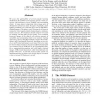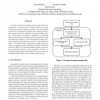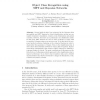84 search results - page 4 / 17 » Eigenspace Method by Autoassociative Networks for Object Rec... |
PAMI
2011
12 years 9 months ago
2011
—We present a discriminative part-based approach for human action recognition from video sequences using motion features. Our model is based on the recently proposed hidden condi...
CVPR
2004
IEEE
14 years 8 months ago
2004
IEEE
We assess the applicability of several popular learning methods for the problem of recognizing generic visual categories with invariance to pose, lighting, and surrounding clutter...
FGCN
2008
IEEE
14 years 1 months ago
2008
IEEE
To realize context aware applications for smart home environments, it is necessary to recognize function or usage of objects as well as categories of them. On conventional researc...
MICAI
2010
Springer
13 years 5 months ago
2010
Springer
Several methods have been presented in the literature that successfully used SIFT features for object identification, as they are reasonably invariant to translation, rotation, sc...
PPSN
2004
Springer
13 years 12 months ago
2004
Springer
Abstract. A key problem in designing artificial neural networks for visual object recognition tasks is the proper choice of the network architecture. Evolutionary optimization met...



